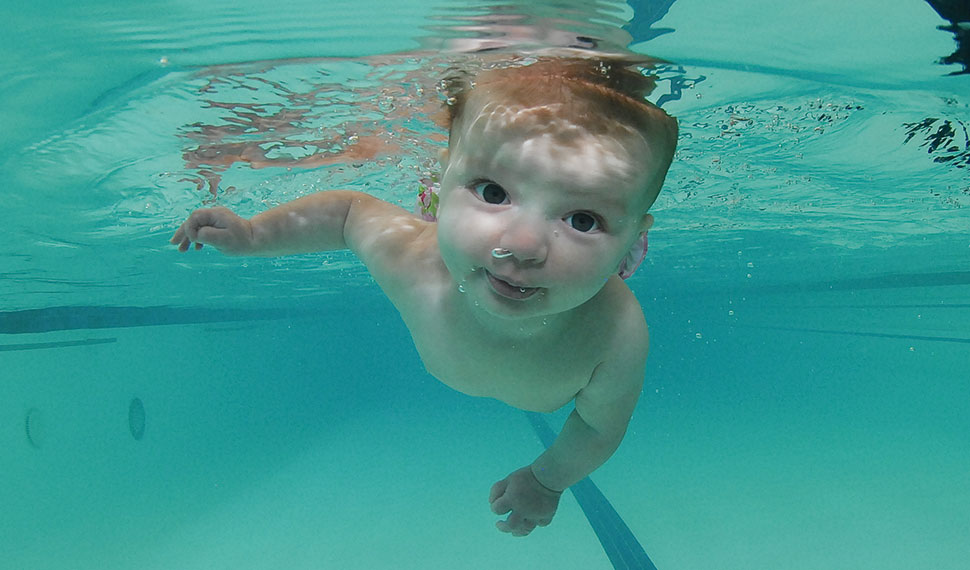
FAQs

- Why is warm water important?
- What’s the best age to start?
- How do you ensure that babies and small children don’t drink or choke on the water?
- What will my child learn in 8 lessons?
- How many lessons should we take?
- What if my child doesn’t like water on his/her face?
- If my child is potty-trained, do they still have to wear two swim diapers?
- When does payment need to be made?
- Why are 4 lessons per week recommended?
- How and when can I schedule lessons?
Why is warm water important?
We keep our pool at 93o year round because it allows our students to swim in a relaxed environment. A cold pool usually results in frigid, shivering students who, in turn, will not be relaxed when it’s time to swim. A warm, relaxed environment lends itself to a comfortable and fluid swimmer. Additionally, since infants are submersed in body- temperature amniotic fluid while in the womb, it is most natural for them to be in a similar environment during their earliest stages of life.
What’s the best age to start?
Our philosophy is: the sooner the better, but it’s never too late. As soon as babies come out of the birth canal, they are ready to swim. We typically wait until the umbilical cord falls off and there’s a bit of head and neck control; starting at around the age of 3 months. The majority of students who start at a very young age will master the water and be able to navigate pools on their own before they turn two. We have also found that children who begin lessons early benefit from advanced development, as they perform better academically and athletically because their brains have been exposed to more oxygen. An oxygen-nourished brain creates a stronger individual, mentally, and physically. Ages 2, 3 and 4 are fine ages to start, although sometimes children at this age experience more anxieties and emotional obstacles. As a child grows and becomes a teenager or an adult, they will often find that it is more of a struggle to learn to swim because of the mental hurdles they must overcome. However, an open mind and commitment can often lead to great success.
How do you ensure that babies and small children don’t drink or choke on the water?
Babies are born with a “swimmer’s reflex”, which stays strong for the first 200 days of life. Basically, this reflex allows children to involuntarily hold their breath when submerged in water, as the environment mimics their surroundings in the womb. In addition, our instructors use a method of teaching in which repetitive motions and verbal cues are used so that students are expecting the submersion. It truly becomes natural and effortless for students, at any age, to learn to hold their breath and swim comfortably.
What will my child learn in 8 lessons?
Progression varies according to several factors. Within a series of eight swim lessons most children will learn to float comfortably with their eyes open. Progress varies from individual to individual; while some students will learn more skills, other may learn less. It is best to keep in mind that, like any athletic endeavor, swim lessons are a commitment if you want the skill to be truly engrained. Our goal is to help children and adults progress through every lesson and make the most of their time in the pool with us. We want our students to leave our program with superb skills and a love of water. For more information, check out “ABOUT OUR PROGRAM: Expectations.”
How many lessons should we take?
Swimming is a skill in which the more time and proper exposure acquired, the better off the swimmer will be. If you want your child to swim safely in a relaxed manner with adequate technique, several series of eight (8) lessons should be expected. Most of our customers notice that after each lesson, their child progresses significantly and since they want such progression and mastery to continue, they proceed with back-to-back series. However, if fun and establishing comfort in water are your goals, fewer sessions will be needed. For more information, our section entitled “ABOUT OUR PROGRAM: Expectations” is quite thorough in answering this question.
What if my child doesn’t like water on his/her face?
Keep in mind that our instructors have a lot of experience with children (and adults) who do not like water on their faces. Ultimately, this is a major component in learning to swim that (we believe) must be overcome. How to we aid this process? Exposure, exposure, exposure; followed by gentle coaxing and a lot of praise. We also request the help of parents in encouraging children to get their faces wet during bath time. Handing a child a dry towel or reaching to wipe their wet face will only prolong and enforce their phobia. If you act like a wet face is no big deal, they will learn to overcome their discomfort around water.
If my child is potty-trained, do they still have to wear two swim diapers?
Absolutely! Two snug-fitting swim diapers are the best way to keep solid waste contained until the child can be removed from the pool. Understandably, this is for the health and safety of all involved. Throughout our many years of experience, we have found that just because a child is potty-trained, doesn’t ensure that they will tell their instructor that they need to use the bathroom. If you don’t feel comfortable calling them “diapers” in front of your child, call them “swim pants.” We sell them on our premises or you can purchase them at various clothing and toy stores throughout San Diego.
When does payment need to be made?
On your first day in our program or your first day returning from a break, we ask that payment be made on the first lesson. Once you’re on a schedule as a current customer, you must reserve the next series by paying on or before lesson #5 (see “Policies“). Paying in advance of each series allows us to schedule ahead. We often have hundreds of students on our waiting lists and in order to meet the needs of current, new and returning customers, it is crucial that we know which of our students are continuing or ending their lessons. Ultimately, we want all students to continue their lessons indefinitely and to leave our program as strong, capable swimmers. However, in the case of an upcoming vacation or break, we appreciate customers communicating that information at least a week in advance.
Why are 4 lessons per week recommended?
4 lessons per week, 20 minutes each, equals 1 hour 20 minutes of swimming per week. Imagine how much time it takes a child to learn to crawl, walk, talk… and that’s a skill they’re practicing during every waking hour! Swimming 4 times per week (or more) is the best way to get maximum results. Two lessons per week are an option available year-round, although lessons at 4 times per week result in more progress than 2 times per week.
How and when can I schedule lessons?
Please call our facility to schedule swim lessons. We schedule lessons 3-5 days in advance of your start date. Just provide us with an idea of which days and window of times are most convenient for you and we will find a schedule that works. If you want to start lessons beyond a week from your phone call (or if your desired class is full), we can put you on a priority waiting list for lessons at a later date.
